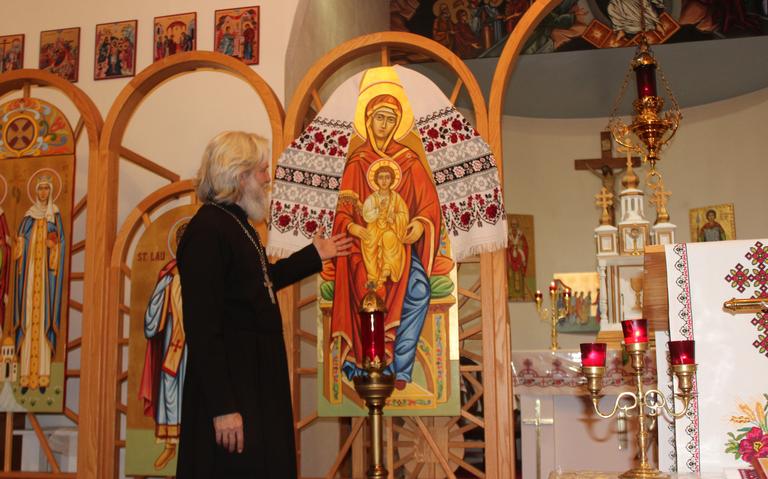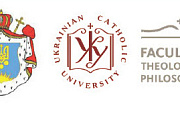"Windows to God": St. Demetrius Ukrainian Catholic Church has a rich frontier history

Written By: Jason O'Day
St. Demetrius Ukrainian Catholic Church was a pillar of the community for Ukrainians who bravely settled the land north of Belfield 120 years ago. We spoke with Father Martin Naggy to learn more about the rich history behind one of the oldest parishes in western North Dakota.
Father Martin Naggy presides over two of the four Ukrainian Catholic Churches in North Dakota — St. John’s and St. Demetrius, both in Belfield.
About 98% of the Catholic Church’s roughly 1.1 billion followers belong to the Roman (Latin) liturgical tradition, but few know that there are in fact five other liturgical traditions comprising the Eastern Church. Within the five liturgical traditions are another 23 sub-sects, with more than half belonging to the Byzantine tradition, or Eastern Roman Empire. Naggy refers to them as the Greco-Catholic Church, which traces its history to Constantinople and the early Christian church.
The Ukrainian Catholic Church is the largest sub-sect with more than 4 million worshipers across the world. The Ukrainian Catholic Church saw a great resurgence in the 1990s after suffering 70 years of persecution under the iron fist of Soviet communism.
It originated in the late 16th century, when some Eastern Orthodox parishes reunited with the Catholic after the Great Schism of 1054. Yet some tensions between Eastern Orthodox Christians and Catholics continued, and even made their way to North Dakota.
In 1916 an Orthodox man began visiting St. Demetrius Parish and urging Catholics to convert. The following year he held Orthodox services there. With the help of the Roman Catholic Bishop in Bismarck, the Ukrainian Archdiocese secured a court order to remove the agitator from the parish.
Unique traditions
During mass at St. Demetrius, Fr. Naggy conducts most of the service facing the same direction as the rest of the congregation, behind an intricately painted wooden gate called an iconastas.
“The priest in our tradition prays with the people. So the whole congregation faces east, including the priest,” Naggy said.
Greco-Catholic parishes like this one continue to use leavened rather than unleavened bread for the Eucharist, which is one of the distinctions that motivated challenges to the Pope’s authority and the Great Schism nearly a millennium ago.
Naggy explained that the distinct customs and theology of his faith are complementary to Roman Catholicism, rather than contradictory.
“Certain things that we emphasize in our theology will illuminate and give different perspectives to the Roman Catholic Church and the things they emphasize will give perspective to us. It’s true of all the Catholic Churches that are in Communion — the Maronites, Melkites, Armenians — they all have certain things that give us a fuller picture of what none of us can fully understand, the whole mystery of God,” he said. “Pope John Paul II said of our Church that we’re Orthodox in worship and Catholic in love. So there is that sense that we’re united in the Catholic Church but we have different ways of worshiping.”
Incense is used during every mass. Another way this church is more Eastern is that they bow upon entering the church instead of genuflecting to the crucifix.
“We venerate the festal icon, saint of the day or saint of the church… We walk up here to our tetrapod and make three bows,” Naggy said. The tetrapod is a table with a picture of the icon Saint Demetrius, a 4th century Christian martyr and courageous soldier who lived in what is now Greece.
Several icons and saints are portrayed in beautiful paintings throughout the front of the church with a noticeably more eastern painting style and perspective. Naggy described them as windows to God.
“Instead of the typical Western style painting where you see the shadows on people’s faces from the light coming in, on these icons the light source is coming from within to reflect that Jesus is present in the icons,” he said. “They’re coming towards us rather than going away like you would see in a typical perspective to show distance.”
Rich history on the Western Edge frontier
“In the late 19th and early 20th centuries there was a wave of Ukrainian and some other Eastern European immigrants. This was more wilderness territory back then. The U.S. Government offered them an opportunity to come out here and homestead,” Naggy said. “It was very hard work for the first immigrants who came over but in this area, a significant number of Ukrainian immigrants settled.”
In 1904 the Ukrainian Catholics got a charter to build a church in their appropriately named community of Ukraina, and St. Demetrius Church was finished two years later. From 1906 to 1945 St. Demetrius had about 17 leading priests, mostly from the Galicia region of what is now western Ukraine. In August 1928 the church and rectory were inexplicably destroyed in a fire, and Fr. Myxajlo Martyniuk rallied the community together to get a new larger church built in the early 1930s.
The parish’s first American born priest came from Berwick, Pennsylvania and studied at a seminary in Rome. Most of his colleagues bristled at the prospect of being sent to North Dakota. Yet, Fr. Michael Bobersky was a hard worker who believed a parish leader must share the lives of his followers.
When Bobersky arrived at St. Demetrius in December 1945 he found himself with no electricity, plumbing or central heat. His modernization initiatives included incorporating English into more of the homilies and Gospel readings. He made a concerted effort to deliver sermons relevant to the times, from which young parishioners were said to derive a deeper sense of meaning. In 1948 blizzards buried the roads and halted church services, with temperatures regularly dropping below -25°F. He was forced to hike many miles to the highway in snow shoes and hitch rides to town for food and basic necessities. The brutal winter prompted moving the entire church building.
The following year Bobersky had the church moved eight miles to a 40 acre plot that was much more accessible and convenient. He subsequently had electricity and a sewage system installed.
“He’s a legend here,” Naggy said. “He had magnificent insight. When they moved the church to this location, he got a grant from the U.S. Government and planted over 1,000 trees here. We’re really blessed here because as you can see, so much of this area doesn’t have trees.”
In an excerpt from a booklet written about the history of the parish, A Century of Faith: 1906-2006, parishioner Germaine Ueckert recalled her fond memories of Bobersky. At night he would often teach children about astronomy and the constellations, she said.
“Father had a keen ability to relate to people from all walks of life,” Ueckert said. “He taught us that religion wasn’t a Sunday phenomenon, but something you practiced in your everyday living. His sermons always portrayed a moral issue, related it to life and put it in terms even young children could understand. At the end of his sermon, Father left us with a question which would be continued the following Sunday.”
Yet Bobersky had a balanced approach as an advocate for his faith. Ueckert explained that he was never coercive in seeking converts to the Church.
In 1949, Bobersky moved St. Demetrius from the Julian to the Gregorian calendar, to celebrate Christmas on Dec. 25 rather than Jan. 7.
Christmas connection
The patron saint of the both Byzantine Catholic Church and the diocese Naggy serves is St. Nicholas, revered for his selfless generosity. Nicholas was the only child of wealthy parents, but devoted his inheritance to religious and benevolent causes. He lived around the same time as St. Demetrius in Lycia, a region in what is now Turkey, where he was imprisoned for his Christian faith. He was later elected Archbishop of the Lycian capital, Myra, by divine intervention. He is most famous for saving three young women, inspiring the folklore of Santa Clause.
“There’s different ways this story is told but if I understand it right, the father had three daughters coming of age, but he was poor and didn’t have a dowry to marry them off properly. So they were likely to be sold off into some sort of servitude and Nicholas heard about it,” Naggy said. “The first time he went in, he had some gold and tossed it through the window. The man had his socks hanging by the fireplace, drying, and the money happened to land in it.”
In another of many stories of kindness, Nicholas heard that a corrupt judge was having an innocent man executed. He ran into the city and freed the man with only minutes to spar.
Every year on a Sunday in early December the parish has someone dressed like a bishop with a white beard deliver presents for children to celebrate the Feast of Saint Nicholas.
“It’s a big holiday, a big feast for us,” Naggy said.
Struck by beauty
Naggy isn’t Ukrainian himself and was raised Roman Catholic in Indianapolis. His father graduated from the University of Notre Dame and took him to many of their football games. He said his transition to the Eastern Church was a long journey, and that his fascination with it began in high school.
“When I was in my early 20s, I studied with the Franciscans and a couple of our friars there were bi-ritual (they used liturgies from both the Roman and Byzantine Churches). So I went to a couple of the Byzantine liturgies there and really liked the Byzantine liturgy. It actually goes back a little further,” he said. “I also went through twelve years of Catholic education. In our freshman year we studied all the different Christian Churches and I was really struck by the Eastern Church.”
Naggy began studying more Eastern Catholic writings and communicating with some of it’s clergy members in Canada, which he said has a higher population of Ukrainians than the United States. Yet, the strongest factor that pulled him in was emphasis on beauty in all aspects of the Byzantine Tradition including the language of the prayers, chanting, singing and use of incense.
“What I feel like God used to draw me in this direction was the beauty of the Church. There’s a real emphasis on beauty in the Eastern Church: the beauty of the liturgy, the beauty of the icons. If it’s done well and the way that it’s meant to be, if you come into a Byzantine Church and a Byzantine liturgy with the singing, incense and icons, your senses are supposed to be overloaded with the beauty of God,” Naggy said. “I still love the Roman Catholic Church. It's not that I felt it was missing anything, but for some reason, those were the things that God used to draw me into the Byzantine Church.”
Video - A History Of Faith - Історія Віри







